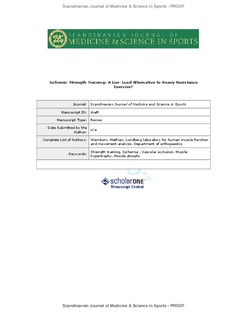| dc.contributor.author | Wernbom, Mathias | |
| dc.contributor.author | Augustsson, Jesper | |
| dc.contributor.author | Raastad, Truls | |
| dc.date.accessioned | 2009-08-14T08:09:49Z | |
| dc.date.issued | 2008-05-04 | |
| dc.identifier | Seksjon for fysisk prestasjonsevne / Department of Physical Performance | |
| dc.identifier.citation | Scandinavian Journal of Medicine & Science in Sports. 2008, 18(4), 401-416 | en |
| dc.identifier.issn | 0905-7188 | |
| dc.identifier.uri | http://hdl.handle.net/11250/170821 | |
| dc.description | I Brage finner du siste tekst-versjon av artikkelen, og den kan inneholde ubetydelige forskjeller fra forlagets pdf-versjon. Forlagets pdf-versjon finner du på www.wiley.com: http://dx.doi.org/10.1111/j.1600-0838.2008.00788.x / In Brage you'll find the final text version of the article, and it may contain insignificant differences from the journal's pdf version. The definitive version is available at www.wiley.com: http://dx.doi.org/10.1111/j.1600-0838.2008.00788.x | en |
| dc.description.abstract | Strength training with low loads in combination with vascular occlusion has been proposed as an alternative to heavy resistance exercise in the rehabilitation setting, especially when high forces acting upon the musculo-skeletal system are contraindicated. Several studies on low-to-moderate intensity resistance exercise combined with cuff occlusion have demonstrated increases in muscle strength and size that are comparable to those typically seen after conventional high-load strength training. However, the physiological mechanisms by which occlusion training induces increased muscle mass and strength are currently unclear, although several candidate stimuli have been proposed. Also, the long-term safety, practicality, and efficacy of this training method are still controversial. Furthermore, recent studies have demonstrated that in some instances, tourniquet cuffs may not be necessary for relative ischemia and significant training effects to occur with resistance exercise at low-to-moderate loads. The aims of the present review are to summarize current opinion and knowledge regarding the physiology of ischemic strength training and to discuss some of the training and health aspects of this type of exercise. In addition, suggestions for further research are given. | en |
| dc.format.extent | 644796 bytes | |
| dc.format.mimetype | application/pdf | |
| dc.language.iso | eng | en |
| dc.publisher | Wiley | en |
| dc.subject | strength training | en |
| dc.subject | ischemia | en |
| dc.subject | vascular occlusion | en |
| dc.subject | muscle hypertrophy | en |
| dc.subject | muscle atrophy | en |
| dc.title | Ischemic strength training: a low-load alternative to heavy resistance exercise? | en |
| dc.type | Peer reviewed | en |
| dc.type | Journal article | en |
| dc.subject.nsi | VDP::Social science: 200::Social science in sports: 330::Other subjects within physical education: 339 | en |
| dc.source.pagenumber | 401-416 | en |
| dc.source.volume | 18 | en |
| dc.source.journal | Scandinavian Journal of Medicine & Science in Sports | en |
| dc.source.issue | 4 | en |
